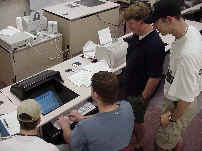|
Domestic violence no longer
acceptable
as Ďfamily affairí
 [JULY
21, 2000] The
message was clear Ė domestic violence is no longer just a
family affair. Itís a community problem, and one that a number of
organizations in Logan County are working to solve. To raise
awareness, members of the Lincoln Police Department, a former
assistant stateís attorney, mental health professionals and an abuse
victim talked to an audience of about 30 Thursday night at the
Johnston Center for the Performing Arts at Lincoln College. [JULY
21, 2000] The
message was clear Ė domestic violence is no longer just a
family affair. Itís a community problem, and one that a number of
organizations in Logan County are working to solve. To raise
awareness, members of the Lincoln Police Department, a former
assistant stateís attorney, mental health professionals and an abuse
victim talked to an audience of about 30 Thursday night at the
Johnston Center for the Performing Arts at Lincoln College.
|
|

[Members of a panel on domestic violence who spoke at a
seminar Thursday evening are, left to right:
Paramedic John Short, Rev. Glenn Shelton of Second Baptist church,
Police Officer Diana Short, Mental Health Specialist Alisin Gosda,
domestic abuse survivor Tina Merchant, Sergeant Thomas Rowland, Dayle
Eldridge of Health Communities Partnership, and Marcia Stall of Logan
Mason Mental Health.]
Tina
Merchant, domestic violence survivor and a member of the Domestic
Abuse and Violence Task Force of the Healthy Communities Partnership (HCP),
explained the process of becoming an abuse victim.
"It
starts with verbal abuse, name calling, erosion of your
self-confidence. You are told you have to quit work. You are isolated
from your family and friends. For me the physical abuse started with
pushing, then dragging me by the hair, then punching me. He shaved my
head and pushed it in the toilet. He choked me until I was
unconscious. He beat me when I was pregnant and when I was holding the
children.
"I
was a strong person, but he broke me down, little by little. He took
away my job, my family, my friends."
Merchant
left her abuser and came to Lincoln, but a year and a half later he
followed her. She sent him away, but on Valentineís Day he came
back, kicked in the locked door, followed her outside and punched and
kicked her unconscious. "If it hadnít been for my neighbor, he
would have killed me," she reported.

Her
abuser is now serving 11 years in prison.
Tim
Butterfield, one of the Lincoln police officers who was called to the
scene, described Merchant as "one of the worst cases Iíve ever
seen. We do have a domestic violence problem in Lincoln that we have
to do something about," he added. "A lot of these crimes donít
get reported because the abused woman feels it her fault. Sheís been
broken down so much."
"For
years and years there were no laws that covered domestic
battery," explained Police Sergeant Thomas Rowland. "The
only thing an abuser could be charged with was battery. And it didnít
work. We were getting the same calls over and over again."
The
attitude of the general public didnít help, either. It was,
"These are family matters and should stay private," Rowland
said. "Once new laws came into effect, things started to
change."
Since
the passage of the Domestic Violence Act in July of 1990, police not
only can but must take action, he said. They can make an arrest,
regardless of the wishes of the victim. Previously, victims had to
state that they wanted their abusing husband or boyfriend arrested,
and many were too frightened or embarrassed to do that.

Also,
police must offer the victim information on what her options are,
offer to find her a safe place to stay, and offer to transport her for
medical treatment. They must also make written reports of all
incidents.
"Iíd
like to have seen this occur long before," Rowland said.
(To top of
second column)
|
Rita
McPheron, former first assistant stateís attorney in Logan County
and now assistant Illinois attorney general, explained that
prosecutors now have more power to put an abuser in prison. Police
reports, pictures, medical records, 911 tapes, records of former abuse
and orders of protection are all good evidence that can be used
without involving the victims.
"We
try to keep victims from having to testify," she said. "Itís
her fault he goes to jail and gets his name in the paper. When heís
out, heís going to go looking for her and she knows it." She
said 90 percent of victims who start to prosecute change their minds
within the first 48 hours.

McPheron
has worked in Lincoln since August of 1999. "Forty percent of the
cases that crossed my desk were domestic violence, and only one out of
10 such cases is reported," she said. "This crime crosses
all barriers Ė cultural, social, financial. And a
batterer doesnít look like a bad guy. He looks like Joe
Ordinary."
McPheron
said Logan County needs domestic violence shelters. "Where do
these victims go in the dead of the night when the blood is fresh and
the tears are stinging, with three small children in pajamas? They
have no money and no place to live. They are afraid they canít
survive on their own, and they try to convince themselves the abuser
will change.
"Abusers
never change unless they are forced to change. Abusers convince
females that itís all their fault."
John
Short of the Logan County Paramedic Association explained that
paramedics must try to convince victims to leave the scene of the
violence and get medical treatment, and they must try to determine if
the injuries the victim has sustained correlate with the story the
abuser tells.

Alison
Gosda and Marcia Stoll of Logan-Mason Mental Health discussed the
myths about domestic violence and the multiple needs of domestic
violence victims. "It takes a community to help in this
situation," Stoll said. "The inability to find emotional and
financial support is the main reason domestic violence victims return
to their abusers.
"They
are embarrassed and ashamed, and they think other marriages are the
same way. They are also afraid DCFS or some other agency will take
their children away from them."
Stoll
also pointed to the need for a shelter. "If I could call a police
officer and say, ĎCan you take this woman and keep her safe?í the
rest would be history."
Merchant
summed up the attitude that abuse victims, and the community, must
take to begin solving the problem of domestic violence.
"Itís
okay that I was abused," she said, "but itís not okay to
accept it."
[Joan
Crabb]
|
|
|
|
|
|

Lincoln College HTML class builds
Web
site for local tourism bureau
[JULY
21, 2000] Thereís
a new language being taught at Lincoln College that is helping the
Abraham Lincoln Tourism Bureau of Logan County. The new class is
Introduction to HTML, which stands for HyperText Markup Language. In
plain English, HTML is a list of instructions that a computer uses
to format pictures and text in the order you want them to appear on
a Web page. The HTML class consisted of eight students who were
given a project to create the Web site for the Logan County Tourism
Bureau. |
|
Todd
Spellman, Lincoln College computer science instructor,
says this was the first HTML class that heís taught at Lincoln
College, and it is already benefiting the community. Spellman said
this exercise gives the students valuable experience by putting what
they have learned into practical use. "Students were assigned
certain pages for different portions of the Web site and were graded
on their execution, cooperation and creative input." The HTML
class is worth three credit hours.

[Students taking the first HTML class
at Lincoln College were Andy Tobias of Barrington, Josh Day of Lincoln,
Tim Tufts of Lansing, Cassie Nighlhossian of Granite City, Eric Fry of
Lincoln, William Eric Ellis of Lincoln, John Malo of Barrington and
John Berry of Indianapolis.]
Josh Day of Lincoln, a
student in the class, said one of the hardest parts of the project
was to create a common design that fit everyoneís taste. Another
student, John Berry of Indianapolis, Ind., thought the project gave
him the insight on what it takes to create a Web site and prepared
him for problems that can happen when setting up a Web page.

The class had their share of
technical difficulties when working on the project. Mysteriously,
the project disappeared from the server one day, and the class was
interrupted. Fortunately, someone in the class had saved their work
on disk, and the project continued.
(To top of
second column in this article)
|

Thressia Usherwood,
executive director of the Abraham Lincoln Tourism Bureau of Logan
County, said the HTML class at Lincoln College helped with putting
local tourism information on the Internet. She said she was
reluctant at first to invest a lot of time and resources in the
creation of a Web site, but with the Lincoln College class providing
the man-hours it was more feasible. Usherwood says she is happy with
the results of the studentís efforts. "Some students went so
far as to go into the local motels and take pictures to include on
the site. We are pleased with the work the students put into our Web
page, and we appreciate all their hard work."

[Lincoln College students work on the
Abraham Lincoln Tourism Bureau Web page with the help of instructor
Todd Spellman.]
The
Abraham Lincoln Tourism Bureau of Logan County Web page address is http://www.logancountytourism.org.
[Jean Ann Miller]
|
|
|
Looking
for Lincoln project forges ahead
[JULY
19, 2000] County
officials and interested citizens will meet at 7 p.m., Wednesday, July
19, in the Union Planters Bank conference room to continue making plans
to implement the Looking for Lincoln project. The purpose of the
project is to draw tourists to Lincoln and Logan County by creating a
historic destination package based on Abraham Lincoln. |
|
At
the last meeting, research historian Bryon Andreasen said that to
ensure that Looking for Lincoln is a success, it will require a
coordinated effort of the countyís residents. And, Wendy Bell, who
serves in an ex-officio role to help community members steer the
process, agrees, and adds: "We need to think big. There are a lot
of possibilities."
The
projectís structure for Lincoln includes a Looking for Lincoln
Master Plan Committee from which several additional committees will
form: the Postville Cluster Committee, Downtown Cluster Committee,
Lincoln College Cluster Committee, Finance Committee, and Publicity
Committee.

The
committees have begun to take shape, with Paul Beaver serving as the
chairman for the Master Plan Committee. Other members of the Master
Plan Committee include Paul Gleason, historian; Beth Davis, county
representative; Jan Schumacher, Main Street representative; Gillette
Ransom, Logan County communities representative; and Charles Ott,
tourism representative.

(To top of
second column in this article)
|

Following
is a list of members for the cluster committees:
Postville
Cluster: Linda Churchill
Downtown
Cluster: Larry Crisafulli, chairman; Larry Steffens, business
representative; and Bernie DePuy, Bill Post, Perry Johnson, Marion
Smith, committee members
Lincoln
College: Dr. Jack Nutt, chairman; Bob Neal, liaison
Publicity:
Penny Zimmerman-Wills
Finance:
Ivan Ray and Shirley Bartelmay
Many
more spaces are yet to be filled for the committees. Input, ideas,
questions and volunteers are welcome at Wednesdayís meeting. For
more information, call Main Street Lincoln, at 732-2929.
[Katherine
Heller]
|
|
|
Part
2
LCHS board members express
concerns about dropout rate
[JULY
19, 2000] Even
though the graduation rate at Lincoln Community High School is on the
rise again, it has been an ongoing matter of concern for school board
members. The rate for 1999, as computed by the State Board of
Education, was 74 percent, while the rate for 2000 will be up to 82
percent. |
|
"I understand the
graduation rate is not where everyone would like to see it," said
Robert Meinershagen, board president and a board member for 12 years.
"When the state figures graduation rates, they look at students
who come in as freshmen. If those students donít graduate in four
years, they donít count. If the student drops out, comes back,
graduates Ė but not in four years Ė that student doesnít count.

"I think the
truancy social worker at Lincoln High is making a difference. I also
feel that parents need to become involved in their childís
education. Some students are self-motivated, but others need a lot of
support. I think weíve got a good administrative team and good
programs to help students at Lincoln High School," he said.

Board Vice-President
Judy Lumpp, who has been on the board since 1991, said, "I think
itís a community problem. I donít think itís just LCHSí
problem. Parents call at the end of the senior year and say, ĎMy kidís
not graduating.í They should have thought about their childís
educational goals at the beginning of the freshman year."
Lumpp believes the
students themselves should take their education more seriously.
"Too many kids who donít need to work are working to support a
car. They donít want to study. Their concerns are their car, their
job and the girl or boyfriend. Theyíre worried about their jobs
today instead of thinking about their employment goals for tomorrow.
"If a student is
interested in graduating there are programs at the high school that
will help," she said. "Iím really proud of the staff. They
do a good job."
Board member Melissa
Frioli also thinks low graduation rates are "a society problem
that we are not going to solve easily. Government canít solve all
our problems, and schools canít solve all our problems. Itís an
issue of responsibility and it starts well before the kids get to high
school," she said.
"The attitude
today is that we are always looking to blame somebody. We have to stop
shifting the blame all over the place and take responsibility for our
own lives and our own actions.

"We offer every
kind of help you can possibly think of. We have summer classes and
night classes. National Honor Society students offer free tutoring.
Teachers give extra help. All the kids have to do is ask. But the
school and administration can only do so much. Ultimately the parents
have to take responsibility for getting the kids to school and the
kids have to take responsibility for doing their schoolwork."
Board member Chuck
Bennett, who has served almost 12 years on the board, wishes the
community would become more involved with the school system.
"Parents should at least be attending school board meetings and
coming to activities at the school. Parents and the community should
know the people who are responsible for their childrenís education.
"Students need
motivation and encouragement from their parents. Many times kids are
disappointed to find they lack a credit and canít graduate. The
school has a responsibility to help them, and their parents or
guardians Ė even some of their peers Ė need to encourage these
students to finish," he said.
He believes the school
is having more success with these students now. "Miss Hubbard and
the staff, with their attitude of reaching out to the students to
encourage them to get into the after-school and summer programs, are
helping."
(To top of
second column in this section)
|
Bennett believes an
important factor at LCHS is the ability of the board and
administration to work together. "There is a tremendous amount of
open communication between the school board and the administration and
between the board and the teachers.
"About two years
ago we put in place a program in which department heads come to board
meetings to make presentations. They talk about their concerns and
their successes. Better lines of communication help us work
together," he said.
"In spite of our
problems, there are far more positive things taking place at LCHS than
negative things," he concluded.
Larry Gleason, who has
served on elementary school boards as well as the high school board,
said he believes programs to help youngsters stay in school need to
start much earlier.
"If kids are not
getting support at home there is very little we can do at ages 14, 15
and 16 years. They have been lost before they get to the high school
level. Weíre shutting the barn door after the horse has already
gotten out.
"Iíve been on
school boards for a long time, implemented different programs, hired
people, written grants. Our graduation rate isnít any better than it
was five or six years ago. If we are spending all this money and still
just treading water, maybe we need to start spending earlier. I
believe we would get more bang for the buck if we started working with
troubled kids in the lower grades.
"Iíve seen a
solid effort from our administration," he continued. "Iíve
seen our staff, both administrators and teachers, bend over backwards
to help these kids. If I could think of better things to do, I would
do them. If other people think of things to do, I wish they would come
forward."

Bridget Schneider, who
was appointed to the board two years ago, says she still has much to
learn, but she believes the programs in place are good ones.
"I have wondered
why the dropout rate began to go up. The school saw the decline before
I came on.
"Perhaps we are
seeing the effects of what has happened economically in our community,
with several big employers leaving. I do believe that has an impact on
families. Also the changing family unit over the long haul to
single-parent families may give the student less support at home and
more financial need."
She believes the
truancy program helps a lot. "It adds another level of support.
It is keeping in touch with the kids, keeping them motivated and
keeping their eye on the goal," she said.
"Also I am very
pleased with the administration and staff we have now. I have seen no
negativity or bickering. We are very fortunate to have a team that
works so well together."
Superintendent Plesť
said he would like to see the graduation rate higher, because that
would indicate "we have fewer students who have problems."
But, he says, education is a very complex process.
"Education has to
do with the development of the human mind. What motivates one child
will not interest another," he said.

"Regardless of their differences, I
want to see all of our students get those diplomas. I am not ashamed
of a school that helps them to do it in six years if that is what they
need."
[Joan
Crabb]
|
|
|
Part 1
LCHS graduation rate on the rise again
[JULY
18, 2000] After
a two-year dip, the graduation rate at Lincoln Community High School
is on the rise again. Computed by a complex state system, the LCHS
numbers show a definite improvement in the year 2000 over the figures
of the two previous years. |
|
Although
some board members and administrators describe the statistics used by
the State Board of Education to compute graduation rates as
"skewed toward the low side" and "inappropriate,"
they do agree that a rise in the graduation rate means more students
are succeeding in getting their diplomas in a four-year period.
In 1999
the state boardís "School Report Card" showed that only 74
percent of LCHS seniors graduated. However, the figures for the year
2000, which have not yet been officially announced by the state, will
be 82 percent, an eight percent increase, according to LCHS Principal
Joyce Hubbard. In 1998 the graduation rate was at 79.3 percent, down
from a high in 1996 of 85.5 percent. In both 1998 and 1999, LCHS fell
below the state averages of 81.8 percent and 81.9 percent.

However,
in the previous three years (1995, 1996 and 1997) the LCHS graduation
rate was as much as five percent above the state average, running 82.7
percent in 1995, 85.5 percent in 1996 and 85.3 percent in 1997. In the
same years, the state average was 80.7 percent, 80.5 percent and 81.6
percent.
Hubbard
says she believes this yearís LCHS rate will be just about at the
state average. "When our rate is 82 percent, Iím guessing the
state rate will be right around that figure as well."
LCHS
Superintendent Frederick Plesť said the graduation rate as computed
by the State Board of Education is based only on students who start at
LCHS and graduate in four years. "Itís not an appropriate
figure because itís not telling the full story," he explained.
"Students who take night courses or correspondence courses and
finish donít get counted in the graduation statistic. It does not
take into consideration students who drop out and return to school
later or students who for some reason need more than four years to
graduate," he said.
This
year, for example, 33 students did not graduate with their class.
According to Hubbard, 11 of those 33 will finish their requirements
and graduate within the coming year, but they will not be counted in
the graduation statistics.
"Every
year, some come back and graduate as fifth-year students," she
explained. "We typically have three, four or five who will get
that diploma after summer school. Maybe they failed something
required, like American history or civics. There are a variety of
reasons Ė we canít pigeonhole what they
need." Others will get diplomas after first or even second
semester next year.

Hubbard
estimates that another 11 of those 33 students will eventually realize
they need a diploma and take the GED. They will not be counted in the
graduation rate, either.
But even
though they are not satisfied with the stateís method of computing
graduation rates, when administrators and board members saw the figure
starting to go down, they determined to do something about it.
"We saw a trend and started putting programs in place to reverse
it," Hubbard said.
"With
some students, there is an attendance problem. Two years ago we got a
state grant to employ a truancy social worker, Janet Hudleson. She
works closely with the dean of students. She is also working with the
families to encourage them to get their children back in school,"
Hubbard said.
(To top of
second column in this section)
|

Hudleson
works with Dean of Students Lorie Lundin in part because that office
handles all attendance records. "We decided that we had to get to
kids fast when they are not coming to school," Lundin said.
"At the first unexcused absence, we call parents and let them
know the child has left school. At the second, we call in the truancy
officer. At the fifth unexcused absence, we set up a meeting with the
parents."
Another
step the school took was to ask for more help from Logan-Mason Mental
Health. That organization has provided counseling services for LCHS
students for the past 10 years, but during the 1999-2000 year a
counselor was available at the school four days a week. "This
counselor can help the students who are having personal problems that
are getting in the way of their education," Hubbard said.
"This gives us one more helping hand."
Last
year LCHS also started an after-school program for students who needed
to make up classes. An evening program and summer remedial programs
were already in place, but the new program gave students one more
option.
"If
they fail a class the first semester, they can make it up in an
after-school program during the second semester. Then they donít get
so far behind and get discouraged," Plesť said.
Most
students who fall behind do so in the first two years, he said, and
tend to drop out at age16. "They look at their record and see
that they havenít passed very many classes. We are trying to help
them stay on track. They are less likely to give up on themselves if
they see we donít give up on them."
LCHS
also has a tutor who works three days a week. The tutorís emphasis
is working with freshman and sophomore students to keep them on that
graduation track, Hubbard said. She also noted that teachers are more
than willing to come in early and stay late to work with students.

Hubbard
has inaugurated still another program to help new students feel
comfortable at LCHS. Before the school year begins, she will visit all
incoming freshmen who have indicated they would like to have a home
visit. "We are trying to bridge the gap from junior high school
to high school," she explained.
Yet
another option for students who donít function well in the ordinary
academic environment is Salt Creek Academy, an alternative education
program housed in a former elementary school in the Athens school
district. This school has a small setting, a self-paced program, less
stimulus and more focus, Hubbard said, and serves students in the
counties of Logan, Mason and Menard. Students can stay from one to
four years in Salt Creek Academy and can elect to come back to the
home school whenever they are ready. Lincoln area Salt Creek students
do get diplomas from LCHS and are counted in the graduation rate
statistics.
"We
do have some students with real hardships, drug problems, family
problems, financial problems," Superintendent Plesť said.
"We are dealing with the full spectrum of problems facing young
people today. Attendance rate is as low as itís been in 10 years.
Six to seven percent of kids just drop out of school.
"We
are trying to help our communityís children obtain their high school
diplomas. It may not be the best way to raise the graduation rate
statistics as the state computes them, but we donít regulate what weíre
doing based on state statistics."
[Joan
Crabb]
[Note:
The second installment of this article includes reactions from
LCHS board members.] |
|



